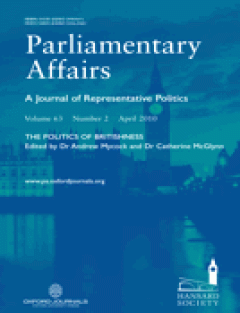Filter by

State Devolution and National Identity: Continuity and Change in the Politics…
Wales is one of the principal cases in Europe where the stateless nation enjoys relatively high levels of identification relative to the state, and is a key focus for addressing identity politics in the UK following devolution in 1997–1999. However, the development and political consequences of Welshness and Britishness are currently relatively neglected in the research literature. This article…
- Edition
- Volume 63, Number 2. April 2010. Pp. 229-249
- ISBN/ISSN
- 00312290
- Collation
- -
- Series Title
- Parliamentary Affairs
- Call Number
- -

English Identities and Interests and the Governance of Britain
Are the identity and interests of the English nation still sufficiently protected by the British state? (the English question). And can the British state still secure sufficient loyalty from all its citizens? (the Britishness question). The omission of England from the programme of devolution implemented by Labour governments since 1999 has not led to a strong demand in England for its inclusio…
- Edition
- Volume 63, Number 2. April 2010. Pp. 250-265
- ISBN/ISSN
- 00312290
- Collation
- -
- Series Title
- Parliamentary Affairs
- Call Number
- -

Britishness (and Irishness) in Northern Ireland since the Good Friday Agreement
This article examines whether the promotion of British values is desirable, feasible or even permissible within Northern Ireland. Here, the advocacy of Britishness may be seen as threatening or offensive to a minority community whose political representatives desire the diminution of symbols of Britishness in order to encourage Irish nationalists to participate in political institutions. The pr…
- Edition
- Volume 63, Number 2. January 2010. Pp. 266-285
- ISBN/ISSN
- 00312290
- Collation
- -
- Series Title
- Parliamentary Affairs
- Call Number
- -

Governance and Identity in a Devolved Scotland
This article focuses on the products of governance in Scotland and the UK, considering policy documents, public announcements and press releases and examines these outputs to consider the presence of Britishness within the institutions, agencies and other groups that govern in Scotland. It is our contention that Britishness, and the idea of Britain, is increasingly absent within the discussion,…
- Edition
- Volume 63, Number 2. January 2010. Pp. 286-301
- ISBN/ISSN
- 00312290
- Collation
- -
- Series Title
- Parliamentary Affairs
- Call Number
- -

Who Doesn't Feel British? Divisions over Muslims
Politicians increasingly promote Britishness. We thus ask who do they think has difficulty feeling British and why do they think this? Scholars have not yet tried to address these questions and in this article we attempt to do so. Using interviews with former home secretaries, junior ministers and their shadow cabinet counterparts, we examine whether leading politicians think that Muslims have …
- Edition
- Volume 63, Number 2. April 2010. Pp. 302-320
- ISBN/ISSN
- 00312290
- Collation
- -
- Series Title
- Parliamentary Affairs
- Call Number
- -

The UK and the European Union: Dimensions of Sovereignty and the Problem of E…
Sovereignty is at the core of the UK's chronically contentious relationship with, and within, the European Union (EU). In order for EU membership to be an expression rather than an erosion of British sovereignty governments must influence the direction of European policy and the level of UK involvement. Labour has, it is argued, established an effective accommodation between continued membershi…
- Edition
- Volume 63, Number 2. April 2010. Pp. 321-338
- ISBN/ISSN
- 00312290
- Collation
- -
- Series Title
- Parliamentary Affairs
- Call Number
- -

British Citizenship and the Legacy of Empires
The Labour government has acknowledged the ‘enormous bonds of commonality’ (T. Blair, speech to Commonwealth Heads of Government, 24 October 1997. http://www.thecommonwealth.org), but the former empire or the modern Commonwealth has remained largely absent in the re-articulation of Britishness. Although there has been little attempt to reform the institutions and symbols of Empire, transnationa…
- Edition
- Volume 63, Number 2, April 2010. Pp. 339-355
- ISBN/ISSN
- 00312290
- Collation
- -
- Series Title
- Parliamentary Affairs
- Call Number
- -

Public Perceptions of the Media's Reporting of Politics Today
The Hansard Society's annual Audit of Political Engagement measures the pulse of the nation on politics and the political system providing an annual benchmark against which it is possible to chart areas of continuity and change. The 2010 Audit also sheds light on public perceptions of media reporting of politics—how they rate the media in terms of impact, satisfaction with how they report polit…
- Edition
- Volume 63, Number 2. April 2010. Pp. 369-376
- ISBN/ISSN
- 00312290
- Collation
- -
- Series Title
- Parliamentary Affairs
- Call Number
- -

Sustainable development, 20 years on: methodological innovations, practices a…
The aim of this introductory paper is to put into perspective some key methodological and practical issues raised by the analysis and implementation of Sustainable Development (SD) approaches in recent years. The key point made here is that, while SD analysis has gained in depth and methodological improvement, implementation issues remain problematic as they underlie serious institutional and s…
- Edition
- Volume 53, Issue 4 June 2010 , pages 427 - 438
- ISBN/ISSN
- 09640568
- Collation
- -
- Series Title
- Journal of Environmental Planning and Management
- Call Number
- -

Society, energy and materials: the contribution of urban metabolism studies t…
Urban areas, in particular cities, are significant consumers of materials and energy, either directly on their land areas or indirectly through the materials, goods and services they import or export; there are upstream and downstream consequences of the removal of resources and the discharge of waste materials (to the atmosphere, water and soils), with multiple impacts on the biosphere. The pr…
- Edition
- Volume 53, Issue 4 June 2010 , pages 439 - 455
- ISBN/ISSN
- 09640568
- Collation
- -
- Series Title
- Journal of Environmental Planning and Management
- Call Number
- -

Territory and energy sustainability: the challenge of renewable energy sources
The issue of energy production is assuming an ever more pivotal role in the most recent international debate on sustainable development. In particular, the development of Renewable Energy Sources (RES) is seen as a great opportunity to achieve sustainability objectives and targets. This consideration reinforces the great debate on the active role of the local dimension in achieving sustainabili…
- Edition
- Volume 53, Issue 4 June 2010 , pages 457 - 472
- ISBN/ISSN
- 09640568
- Collation
- -
- Series Title
- Journal of Environmental Planning and Management
- Call Number
- -

Policy integration strategy and the development of the 'green economy': found…
In several countries, the remarkable development of the 'green economy' in recent years has gone hand in hand with the implementation of strategies of integration (more or less rapid and thorough) of public policies linked to the environment. This policy integration strategy is generally a necessary condition for the encouragement and viable development of new environmental technologies and com…
- Edition
- Volume 53, Issue 4 June 2010 , pages 473 - 490
- ISBN/ISSN
- 09640568
- Collation
- -
- Series Title
- Journal of Environmental Planning and Management
- Call Number
- -

Sustainability and multi-level governance of territories classified as protec…
This paper draws on recent debates on the multi-level governance of sustainable development to approach territories classified as protected areas. Based on original fieldwork carried out in the Parc naturel reacutegional du Morvan, the paper examines the main governance challenges arising from the coexistence of natural areas and various embedded politico-administrative territories that have fl…
- Edition
- Volume 53, Issue 4 June 2010 , pages 491 - 509
- ISBN/ISSN
- 09640568
- Collation
- -
- Series Title
- Journal of Environmental Planning and Management
- Call Number
- -

Traditional knowledge and biocultural diversity: learning from tribal communi…
This paper presents a synthesis of grassroots activities designed to promote the learning and conservation of traditional knowledge and related biocultural resources among Adi, Monpa and Khasi tribes of northeast India. The results indicate that the participation of knowledge holders in various village level activities can enhance the promotion of traditional practices, learning of knowledge an…
- Edition
- Volume 53, Issue 4 June 2010 , pages 511 - 533
- ISBN/ISSN
- 09640568
- Collation
- -
- Series Title
- Journal of Environmental Planning and Management
- Call Number
- -

A BIT Is Better Than a Lot: Bilateral Investment Treaties and Preferential Tr…
The landscape of the global economy is dotted with institutions that regulate investment and trade. In recent years, the number of bilateral investment treaties (bits) and preferential trade agreements (ptas), in particular, has grown at a torrid pace; practically every country is a member of at least one—if not many—of these institutions. For all the scholarly attention that these institutio…
- Edition
- Vol. 62, No. 1 January 2010. pp. 1-42
- ISBN/ISSN
- 00438871
- Collation
- -
- Series Title
- WORLD POLITICS
- Call Number
- -

Defeating Dictators: Electoral Stability and Change in Competitive Authoritar…
What explains electoral stability and change in competitive authoritarian regimes? This article addresses this question by comparing eleven elections—six of which led to continuity in authoritarian rule and five of which led to the victory of the opposition--that took place between 1998 and 2008 in competitive authoritarian regimes countries located in the postcommunist region. Using intervie…
- Edition
- Vol. 62, No. 1 January 2010. pp. 43-86
- ISBN/ISSN
- 00438871
- Collation
- -
- Series Title
- WORLD POLITICS
- Call Number
- -

Why Do Ethnic Groups Rebel? A New Data and Analysis
- Edition
- Vol. 62, No. 1 January 2010. pp. 87-119
- ISBN/ISSN
- 00438871
- Collation
- -
- Series Title
- WORLD POLITICS
- Call Number
- -
- Edition
- Vol. 62, No. 1 January 2010. pp. 87-119
- ISBN/ISSN
- 00438871
- Collation
- -
- Series Title
- WORLD POLITICS
- Call Number
- -

After KKV: The New Methodology of Qualitative Research
This article discusses developments in the field of qualitative methodology since the publication of King, Keohane, and Verba’s (kkv’s) Designing Social Inquiry. Three areas of the new methodology are examined: (1) process tracing and causal-process observations; (2) methods using set theory and logic; and (3) strategies for combining qualitative and quantitative research. In each of these a…
- Edition
- Vol. 62, No. 1 January 2010. pp. 120-147
- ISBN/ISSN
- 00438871
- Collation
- -
- Series Title
- WORLD POLITICS
- Call Number
- -

Studying the State through State Formation
This article seeks to take stock of the insights offered by the fast-growing literature on comparative state formation, which is treated here as a neglected offshoot of the “bringing the state back in” movement of the 1980s. Unlike previous Eurocentric reviews of this literature, this article includes works that range broadly in time and geography. The author focuses particularly on two areas o…
- Edition
- Vol. 62, No. 1 January 2010. pp. 148-175
- ISBN/ISSN
- 00438871
- Collation
- -
- Series Title
- WORLD POLITICS
- Call Number
- -

The Problem of Consumption
One of the biggest challenges for global environmental governance is “the problem of consumption.” The task involves far more than simply influencing what consumers choose, use, and discard. It requires a concerted effort to address the systemic drivers—including advertising, economic growth, technology, income inequality, corporations, population growth, and globalization—that shape the quanti…
- Edition
- Vol. 10, No. 2, May 2010, Pages 1-10
- ISBN/ISSN
- 15263800
- Collation
- -
- Series Title
- Global Environmental Politics
- Call Number
- -
 Computer Science, Information & General Works
Computer Science, Information & General Works  Philosophy & Psychology
Philosophy & Psychology  Religion
Religion  Social Sciences
Social Sciences  Language
Language  Pure Science
Pure Science  Applied Sciences
Applied Sciences  Art & Recreation
Art & Recreation  Literature
Literature  History & Geography
History & Geography